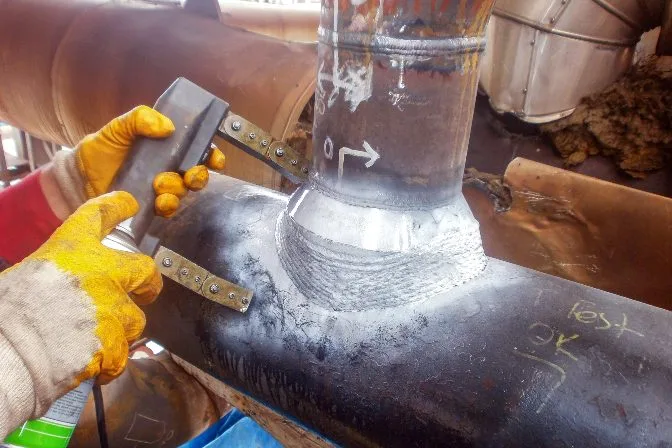A Detailed Overview of Storage Tank Welding Inspection Specifications and Methodologies for Improved Weld Quality and Performance
The importance of welding inspection criteria in the manufacturing of tanks can not be overstated, as they work as the backbone for making sure weld honesty and functional dependability. Numerous assessment techniques, including aesthetic analyses and advanced non-destructive screening methods, are important in determining possible flaws that could endanger performance. Sticking to regulative standards not only enhances weld high quality however also reduces the risk of costly failures. As we check out the nuances of these methods, it ends up being imperative to consider exactly how an organized approach can revolutionize existing techniques and lead to significant enhancements in results.
Significance of Welding Evaluation Standards

Welding assessment standards encompass a series of requirements, including product specifications, welding treatments, and qualifications of employees involved in the welding procedure. By enforcing these standards, companies can methodically recognize and fix potential problems, consequently reducing the possibility of costly fixings or catastrophic failings. In addition, strenuous examination practices foster a culture of responsibility and precision, encouraging welders to preserve high degrees of workmanship.

Common Welding Assessment Techniques


Ultrasonic Checking (UT) is one more prevalent technique, using high-frequency acoustic waves to spot inner defects that might not be visible on the surface. This method is specifically reliable for determining voids or additions within the weld metal. Magnetic Particle Examining (MT) is likewise extensively utilized, especially for ferromagnetic materials, as it reveals surface area and near-surface defects via the application of magnetic fields and ferrous bits.
Furthermore, Liquid Penetrant Screening (PT) detects surface-breaking issues by applying a penetrant to the weld and afterwards making use of a developer to draw out the penetrant. Each of these techniques contributes to a detailed inspection approach, making certain that welds fulfill the rigorous top quality requirements called for in container construction.
Governing Specifications and Conformity
Governing standards and compliance are important components in making sure the safety and security and reliability of welded frameworks in storage tank building - Tank Welding Inspection. These requirements offer to establish minimum requirements for material buildings, welding treatments, and assessment methods, consequently reducing the risk of architectural failings and improving overall efficiency
Trick companies, such as the American Society of Mechanical Engineers (ASME) and the American Welding Culture (AWS), give standards that are commonly embraced in the industry. Conformity with these requirements not only ensures adherence to ideal methods but also satisfies lawful and contractual responsibilities, securing the passions of stakeholders.
Regulatory bodies frequently mandate adherence to certain codes, such as ASME Code Section IX for welding credentials and API 650 for welded containers. These codes describe needs for welding methods, certifications of employees, and screening techniques to confirm straight from the source weld integrity.
Routine audits and evaluations are critical to maintaining conformity, as they aid determine discrepancies from established standards. Non-compliance can lead to significant penalties, job delays, and safety and security hazards. Hence, a durable understanding of governing criteria and a dedication to conformity are paramount in attaining premium and durable bonded tank frameworks.
Non-Destructive Testing Methods
How can the stability of welded structures be ensured without causing damages? Non-destructive screening (NDT) approaches use a robust service, enabling examiners to examine weld top quality without compromising the product - Tank Welding Inspection. Amongst the most common NDT strategies are ultrasonic testing (UT), radiographic testing (RT), magnetic bit screening (MT), and color penetrant screening (PT)
Ultrasonic testing employs high-frequency sound waves to detect internal flaws and characterize product residential properties. It provides precise measurements and is specifically effective for thick products. Radiographic screening involves passing X-rays or gamma rays via the weld, producing pictures that expose structural flaws such as cracks or gaps. This method is vital for assessing the integrity of complex welds.
Magnetic fragment testing is matched for ferromagnetic products, where electromagnetic fields disclose surface and near-surface discontinuities. Color penetrant screening uses a liquid additional resources dye to highlight surface-breaking defects, making it a reliable approach for non-porous products.
Each of these NDT techniques has distinct advantages, enabling extensive assessments customized to particular materials and welding procedures. By carrying out these strategies, sectors can guarantee the dependability and security of welded frameworks, inevitably improving general efficiency.
Enhancing Weld Quality Via Evaluation
Efficient examination plays an important duty in boosting weld top quality, acting as a vital checkpoint in the fabrication procedure. By determining prospective defects early, examinations reduce the danger of endangered structural integrity and make certain compliance with sector criteria. Using a mix of visual assessments, non-destructive screening (NDT) techniques, and mechanical analyses, assessors can find problems such as porosity, splits, and incomplete blend.
Implementing a durable inspection protocol not just enhances the total high quality of welds but also promotes a society of liability among welders and makers. Normal training and accreditation of evaluation workers guarantee that they are outfitted with the necessary abilities to recognize and resolve possible issues properly. This positive strategy lessens rework and click over here now associated costs, ultimately adding to predict performance.
Moreover, thorough paperwork of examination findings gives useful insights into reoccuring issues, assisting in constant enhancement in welding techniques. By leveraging sophisticated modern technologies, such as automated ultrasonic screening or digital radiography, weld high quality can be enhanced through extra accurate analyses. To conclude, a rigorous assessment procedure is vital in attaining premium welds, making certain security, reliability, and long life in tank fabrication.
Final Thought
To conclude, the implementation of extensive tank welding inspection requirements and approaches is essential for guaranteeing weld stability and efficiency. By making use of a mix of visual inspections, non-destructive screening approaches, and adherence to regulative requirements, companies can successfully determine and reduce prospective problems. Promoting a culture of accountability amongst welders even more boosts the high quality of welding procedures. Ultimately, these techniques add to reduced structural failures, reduced repair service costs, and enhanced functional efficiency within the market.